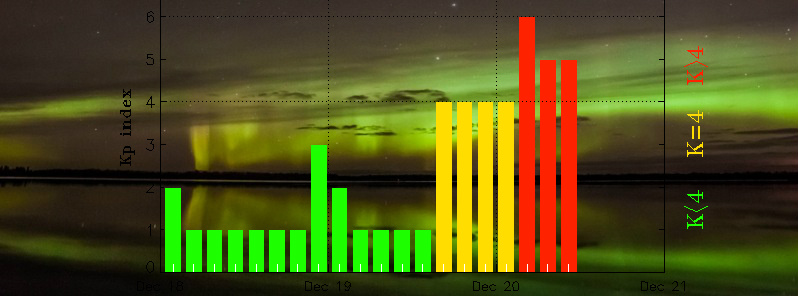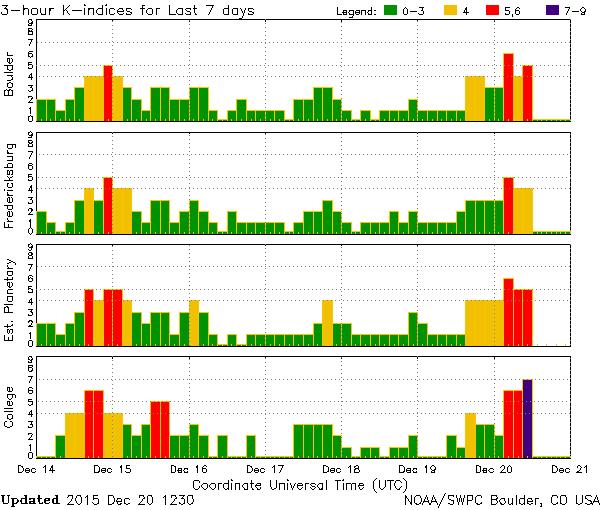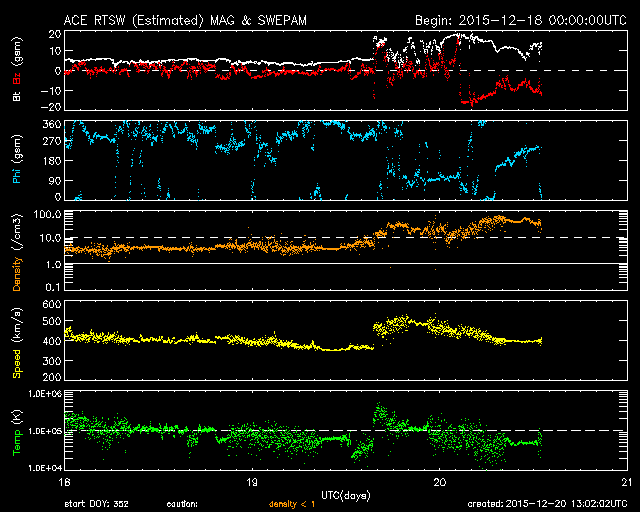Geomagnetic storms reaching G2 Moderate levels in progress

A halo Coronal Mass Ejection (CME) generated by December 16th C6.6 solar flare has reached our planet on December 19 causing enhanced solar wind conditions, prolonged period of the southward magnetic field and planetary geomagnetic storms reaching G2 Moderate levels.
The CME was observed at the ACE spacecraft at 15:28 UTC on December 19 and reached our planet at 16:17 UTC. According to WSA-ENLIL model, the second and somewhat brighter full halo CME from December 16 – a result of an eruptive event along a filament channel in the southeast quadrant of the Sun – has most likely combined with the C6.6 CME.

Video courtesy of SolarHam
During the last 24 hours (by 12:30 UTC today), the greater than 2 MeV electron flux was at predominately moderate to high levels with a brief period of normal levels from 02:46 – 05:35 UTC on December 19. A peak flux of 2,825 pfu was observed at 16:55 UTC on December 19. The greater than 10 MeV proton flux continued at background levels.
According to the SWPC, the greater than 2 MeV electron flux is likely to drop to normal to moderate levels on December 20 due to electron redistribution associated with the arrival of the December 16 CMEs. Moderate to high levels are expected on December 21 and 22 as CME impacts wane. The greater than 10 MeV proton flux is expected to continue at background levels.
The total field strength (Bt) ranged between 10-17 nT through most of the period.
Geomagnetic K-index of 5 (G1 – Minor geomagnetic storm) threshold was reached at 04:53 UTC on December 20 while Geomagnetic K-index of 6 (G2 – Moderate) threshold was reached at 05:19 UTC.


After 10:00 UTC on December 20 field conditions began to stabilize and decreased to near 5-7 nT. The Bz component varied until near 02:30 UTC on December 20 when it switched to a sustained southern orientation, reaching a maximum deflection of -17 nT. By period's end, Bz had decreased to near -5 nT.
Solar wind speed reached near 520 km/s with shock passage and remained elevated until near 00:00 UTC on December 20 when speeds began to gradually decrease to about 395 km/s to end the period.
At shock passage, and through period's end, phi was variable between a negative and a positive (away from the Sun) orientation.


Solar wind parameters are expected to remain enhanced on December 20 due to CME influences. They are expected to diminish slowly by late on December 20.
A gradual return to low conditions is expected on December 21 and 22 as CME effects wane.
Featured image credit: Background by Zoltan Kenwell, Kp Index data by NOAA/SWPC. Edit: TW

Commenting rules and guidelines
We value the thoughts and opinions of our readers and welcome healthy discussions on our website. In order to maintain a respectful and positive community, we ask that all commenters follow these rules.